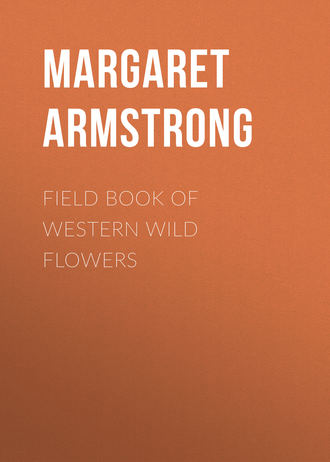 полная версия
полная версияField Book of Western Wild Flowers
Miner's Lettuce
Móntia parviflòra
White
Spring, summer
West, except Ariz.
The Indians gather these pretty succulent little plants for salad and indeed the tender, bright-green leaves look as if they would taste very nice. They grow in a loose bunch, with several stems, a few inches to a foot high. The root-leaves have long leaf-stalks and vary very much in size and shape, the earliest being long and narrow, like little green tongues, but the later ones oval, round and kidney-shaped, and they vary also in tint, in dry places being sometimes a dull yellowish-pink. The stem-leaves are quite odd, for a single pair have united around the stem and become a circular or somewhat two-lobed disk, one or two inches broad, the stalk piercing right through its center. This leaf forms a pretty, shallow saucer, with a small, loose cluster of tiny flowers, on slender flower-stalks, springing from the middle. This is common everywhere in orchards or vineyards, and in shady places in the foothills and canyons, and has long been cultivated in England for salad. It is also called Indian Lettuce and Squaw Cabbage. M. perfoliàta is similar.

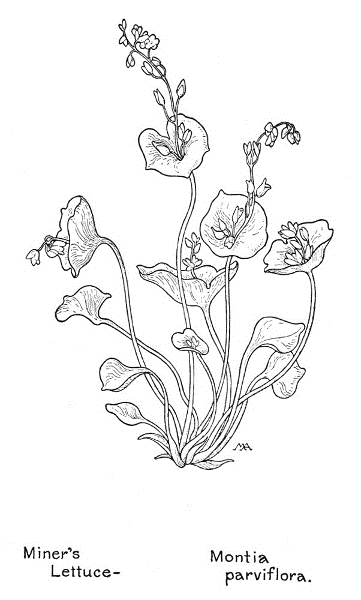
Miner's Lettuce – Montia parviflora.
Spring Beauty
Móntia parvifòlia
White and pink
Spring
Northwest
This charming little flower resembles the Spring Beauty of the East, Claytonia Virginica, and blooms in late spring, among the ferns and wet grasses near the Yosemite waterfalls and in similar places. The white flowers, about three-quarters of an inch across, are often tinged with pink and the five stamens are violet. The tender stems, about eight inches tall, are weak and almost trailing and the pale-green leaves are smooth, the lower ones slightly thick and succulent, with little bulblets in the axils, which drop off in drying; the capsule mostly has only one seed.
There are several kinds of Claytonia, resembling Montia.
Spring Beauty
Claytònia lanceolàta
Pink and white
Spring
Northwest, Cal., Nev., and Utah
A pretty little plant, three or four inches high, with a juicy, reddish stem and thickish, bluish-green, juicy leaves, the root-leaf narrow, the two stem-leaves broader. The flowers, over half an inch across, are white, tinged and delicately veined with pink, with a little yellow at the base of the petals; the pistil and stamens pink; the two sepals yellowish-green. This grows on moist mountain slopes, up to an altitude of nine thousand feet, sometimes at the edge of the snow, is pretty and delicate and also resembles the eastern Spring Beauty.
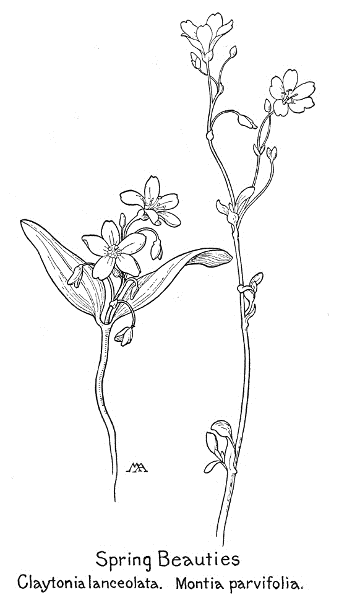
Spring Beauties
Claytonia lanceolata.
Montia parvifolia.

There are only one or two kinds of Spraguea, natives of North America; low herbs, not very succulent, with fleshy roots; the leaves alternate, or from the root; the small flowers in coiled clusters; the two sepals and the four petals all papery; the stamens one, two, or three in number; the style long, with two stigmas; the capsule roundish, with two valves, containing few or many, shining, black seeds.
Pussy-paws
Spràguea umbellàta
(Calyptridium)
Pink
Summer, autumn
Northwest
Sandy spots in the mountains are often brightened by lovely patches of the soft pink blooms of this attractive and odd-looking little plant. Near Wawona, on the Glacier Point trail, I saw at least half an acre of sand carpeted with beautiful rose-color. In moderate altitudes the plants are about ten inches tall, but they get dwarfish as they climb and on the mountain-tops they are only an inch or so high, with close mats of small leaves. They have strong tap-roots and the leaves are dull gray-green, rather thick and stiff but hardly succulent, and grow mostly in rosettes at the base, those on the stem having shrunk to mere bracts, with several, smooth, reddish stalks springing from among them. Each stem bears a close, roundish head, two or three inches across, consisting of many tightly-coiled tufts of shaded pink, each composed of innumerable, small, pink flowers, the papery, pink and white sepals and bracts being the most conspicuous part. They overlap each other and have daintily ruffled edges. The three stamens are long and protruding and the style long and threadlike. The flower-clusters are like soft pink cushions, so the pretty little name of Pussy-paws is appropriate, both to form and coloring. Chipmunks are very fond of the small, black seeds.

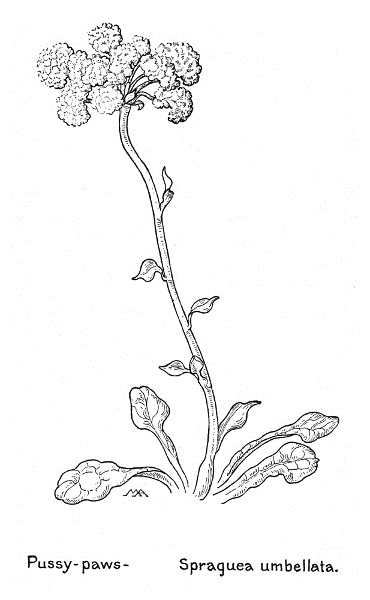
Pussy-paws – Spraguea umbellata.
BUTTERCUP FAMILY. Ranunculaceae
The members of this large and handsome family vary so much in appearance that it is difficult for the amateur to realize that they are nearly related. In fact they have no very distinctive characteristics. They are all herbs, except Clematis, which is shrubby, and all have bitter juice, which is never milky or colored, numerous stamens and usually several pistils, which are superior and one-celled, bearing a single style, and all the parts of the flower are separate from each other and inserted on the receptacle. The flowers are often of eccentric forms, with spurs or hoods; sometimes they dispense with petals altogether and instead have colored sepals which resemble petals. The leaves are of all sorts and shapes, usually more or less lobed and cut, but have no stipules and often their bases clasp the stem. The fruit is an akene, pod, or berry. Many of our most beautiful and popular garden flowers are included in this family, which is large and distributed throughout the world, but not abundant in the tropics.
There are numerous kinds of Ranunculus, mostly perennials, with fibrous roots, growing in temperate and cold regions. Ours have yellow or white flowers, with three to five sepals and from three to fifteen petals, each of the petals with a nectar-gland at its base; the numerous pistils developing into a roundish or oblong head of akenes. The leaves are variously cut and lobed, the stem leaves alternate. Some sorts grow in the water and some have creeping stems. Some kinds of Ranunculus are liable to be confused with some sorts of Cinquefoils, but the calyx of a Buttercup has no bractlets, as has that of a Cinquefoil. The Latin name means "little frog," as these plants like marshes.
Common Western Buttercup
Ranúnculus Califórnicus
Yellow
Winter, spring
Wash., Oreg., Cal.
The commonest kind are attractive, often coloring the fields for miles with bright gold, but the flowers are not so pretty as some common eastern kinds. The stems are branching and more or less hairy, nine inches to a foot and a half tall, with dark-green leaves, smooth, hairy or velvety, and velvety, hairy buds. The flowers are about an inch across, with from nine to sixteen, bright-yellow, shiny petals and pale-green sepals, turned closely back. The akenes have hooked beaks. This runs into many scarcely distinguishable varieties.
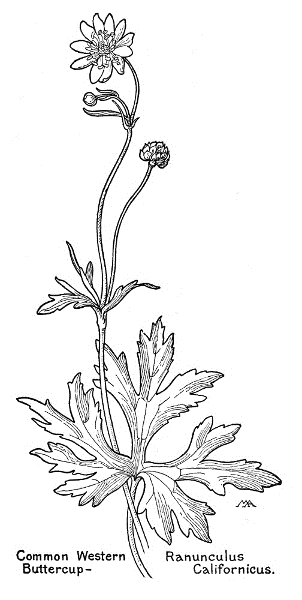
Common Western Buttercup – Ranunculus Californicus.
Few flowers are more beautiful and interesting in color and construction than Larkspurs. We are all familiar with their tall spires of oddly-shaped blossoms, growing in gardens, and we find them even more charming in their natural surroundings, glowing like sapphires on desert sands, or adorning mountain woods with patches of vivid color. There are many kinds; ours are perennials, with palmately-divided leaves and usually blue or white flowers, very irregular in form, with five sepals, resembling petals, the upper one prolonged into a spur at the back, and usually four petals, two of which are small and inside the calyx-spur, the larger two partly covering the pistils and the numerous stamens. The pistils, from one to five, become many-seeded pods. Some Larkspurs are poisonous to cattle. The Latin name is from a fancied resemblance of the flower to the dolphin of decorative art. Spanish Californians call it Espuela del caballero, Cavalier's spur.
Blue Larkspur
Delphínium scapòsum
Blue
Summer
Ariz., New Mex.
Though sometimes rather small, this is extremely pretty. In the Grand Canyon, on the plateau, it is about a foot tall, with rather leathery, brownish-green leaves, mostly from the root, and from five to twelve flowers in a cluster. They measure nearly an inch across and are brilliant and iridescent in coloring, as except for two small whitish petals, they are the deepest, brightest blue, exquisitely tinted with violet, with brown anthers. At Tucson, among the rocks above the Desert Laboratory, it grows to over a foot in height, with a cluster over six inches long and light dull-green leaves, slightly stiff and thick, with long leaf-stalks, the lobes tipped with a bristle, forming a handsome clump. This grows on dry plains and rocky hillsides, up to seven thousand feet. The picture is from a Grand Canyon plant.
Larkspur
Delphínium Hánseni
White, pinkish
Summer
California
If the flowers were a little less pale in color this would be a gorgeous plant, for it sometimes grows nearly four feet high. The branching stem springs from a cluster of thick, tapering roots, each branch terminating in a long, crowded cluster of twenty or thirty flowers, opalescent in tint, either white, with a bluish or greenish spot on the tip of each sepal, or very pale pink, with a purplish or bluish spot. The dull, yellowish-green leaves are rather thickish and downy, the pods erect. This grows in dryish places, at moderate altitudes, and freely around Yosemite.
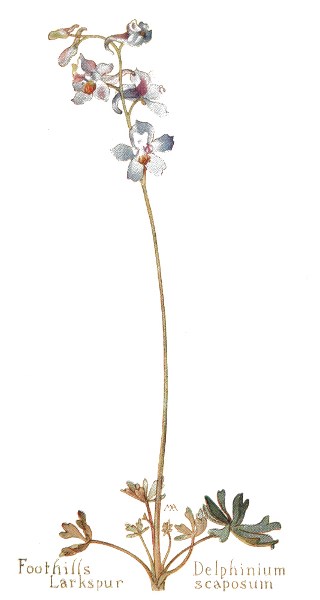
Foothills Larkspur – Delphinium scaposum.
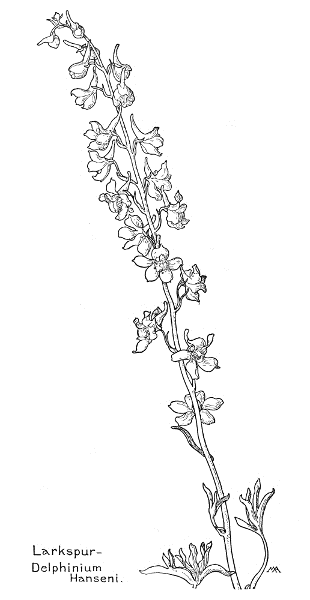
Larkspur – Delphinium Hanseni.

Blue Larkspur
Delphínium bícolor
Blue
Spring, summer
Northwest and Utah
A splendid flower when at its best, from six inches to a foot and a half tall, with a smooth stem, reddish below, and smooth, bright-green leaves, pale on the under side, round in general outline, the lower ones with long, reddish leaf-stalks sheathing the stem, the roots thick but not tuberous. The beautiful flowers are sometimes an inch and a half across, on long, rather spreading pedicels, few or many, in a long loose cluster, the buds slightly downy. The general effect of the flowers is deep bright-blue, but when we examine them more closely we find that the slightly woolly spurs are purplish, the blue sepals have on the back protuberances, which are pinkish on the front and greenish on the back, the two, small, upper petals are white, delicately striped with purple, and the lower ones, which are fuzzy with tufts of white down and two-cleft, are deep pinkish-purple; sometimes the whole flower is much paler in color. The anthers are large and green at first, becoming small and yellow, their threadlike filaments curling. This grows on dry hills. D. Párryi, of California, is about two feet tall, similar in coloring, but even handsomer, with a cluster nearly a foot long, closely crowded with beautiful flowers, each an inch and a half across. The lower leaves are slashed nearly to the center, into seven divisions, each with three, long, narrow lobes.

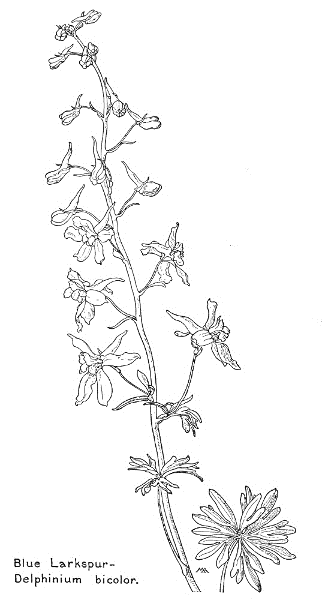
Blue Larkspur – Delphinium bicolor.
Sacramento Larkspur
Delphínium variegàtum
Purple
Spring, summer
California
Very handsome, over a foot tall, the upper stem downy, the lower more or less hairy and the leaves more or less velvety. The flowers are an inch or more long and rather few, with long pedicels, forming a loose cluster. They are downy on the outside, all bright-purple, except the two upper petals, which are white tipped with purple, the lower petals edged and tipped with hairs, the spur stoutish and wrinkled. These flowers, though described as blue, seem to me to have more true purple than most Larkspurs. They probably vary a good deal in color. This grows in the Coast Ranges and the Sacramento Valley. There are many similar blue Larkspurs.
Scarlet Larkspur, Christmas-horns
Delphínium nudicaùle
Red
Spring
Wash., Oreg., Cal.
Scarlet seems an odd color for a Larkspur, but there are two red ones in the West. This is an exceedingly airy, graceful plant and suggests a Columbine more than a Larkspur. The stem is slender and branching, from one to over two feet tall, with a "bloom"; the leaves thickish, smooth, dark rich green on the upper side and pale on the under. The flowers are far apart, from two to twelve, on long pedicels, forming a very loose, open cluster. Each flower is about an inch long; the sepals scarlet shading to yellow, the spur tipped with deeper red, the petals yellow tipped with crimson, not woolly, the two upper notched and much larger than the two lower ones, which are small and slashed into two points, the edges of both sepals and petals more or less hairy; the buds pale yellowish-green, tinged with pink and red. These charming flowers have an elfin look all their own, as they swing their little pointed red caps in the light shade of cool canyons along the mountain streams they love. In southern California we find D. cardinàle, a handsomer plant, sometimes six feet tall, its flowers larger and deeper red and forming a larger, closer cluster.
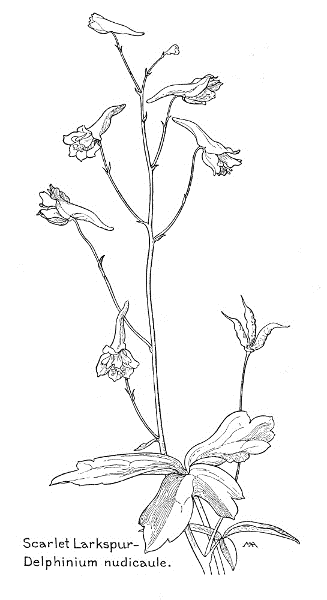
Scarlet Larkspur – Delphinium nudicaule.
The picturesque Columbine gets its melodious name from the Latin for "dove," because the spurs suggest a circle of pretty little pigeons, and this common name is less far-fetched than the Latin one, Aquilegia, which comes from a fancied resemblance of the spurs to an eagle's claws. These plants are well known and easily recognized by the peculiar shape of the flowers. Everything about them is decorative and beautiful, the foliage is pretty and the flowers large, brightly colored, and conspicuous. They are all perennials, with branching stems and compound leaves; the flowers usually nodding, with five sepals all alike and resembling petals, and five petals, also all alike, with conspicuous, hollow spurs. The stamens, the inner ones without anthers, are numerous and the five pistils develop into a head of five, erect, many-seeded pods. There is honey in the spurs, which can be reached only by "long-tongued" insects or humming birds, which thus assist in cross-pollination, and bees obviate the difficulty of having short tongues by ingeniously cutting holes in the spurs. There are a good many beautiful kinds, both East and West.
Scarlet Columbine
Aquilègia truncàta
Red and yellow
Spring
Wash., Oreg., Cal.
This charming plant grows from one to over three feet high, is branching and smooth, and has pretty light-green leaves and nodding flowers, which are over an inch and a half across. The outside of the corolla is pale-scarlet, veined and tipped with yellow, the inside is yellow and the spurs are erect and three quarters of an inch long. The flower resembles the Scarlet Columbine of the East, but the plant is taller, with fewer flowers. It is common in moist, rich woods in Yosemite and the Coast Ranges, from the foothills well up to the alpine zone.
White Columbine
Aquilègia leptocèra
White
Summer
Northwest and Utah
An exceedingly beautiful flower, a white sister of the large Blue Columbine, which is the "State flower" of Colorado, and sometimes sufficiently tinged with blue to show the relationship. It is a rather slender plant, usually with several stems, from one to two feet tall, the foliage rather bluish-green, the flowers large and usually pure-white, and is found in the mountains.
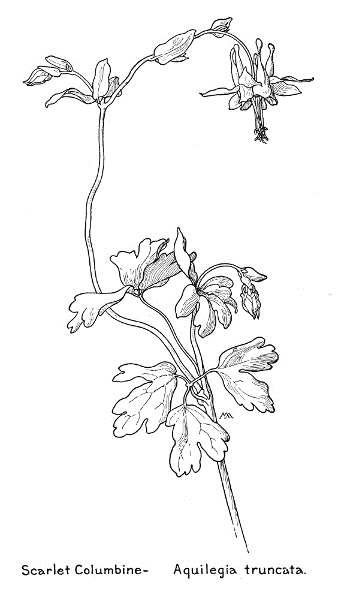
Scarlet Columbine – Aquilegia truncata.

Monkshoods have almost as much charm as their cousins Columbine and Larkspur, with a quaintness and individuality all their own. There are a good many kinds; mountain plants, growing in temperate regions, with rather weak stems and leaves much like those of Larkspur. The blue and white blossoms have a "hood," which gives these plants their very appropriate name. This is formed by the upper and larger one of the five, petal-like sepals arching over and forming a hood, or helmet, under which the two small petals, with spurs and claws, are hidden; sometimes there are three or more petals below, which are minute and resemble stamens. The real stamens are numerous and ripen before the pistils, thus ensuring cross-pollination, and the fruit consists of a head, of from three to five, many-seeded pods. The thick or turnip-shaped root is used medicinally and is virulently poisonous, so these plants are sometimes called Wolfsbane. Aconite is the ancient Greek name and other common names are Blue-weed and Friar's-cap.
Monkshood
Aconìtum Columbiànum
Blue and white
Summer
West
This handsome perennial, from two to six feet tall, grows near streams, in mountain meadows or open woods. The flowers measure from half an inch to over an inch long and are mostly bright-blue and white, tinged with violet, but shade from almost white to deep-blue, veined with purple. They are paler inside and grow on slender pedicels, in a long loose cluster, on a somewhat bending stem. The two, small, hammer-shaped petals are nearly concealed under the hood. The leaves are alternate, the lower ones with long leaf-stalks, and deeply cleft into three or five, toothed or lobed, divisions. This reaches an altitude of twelve thousand feet.

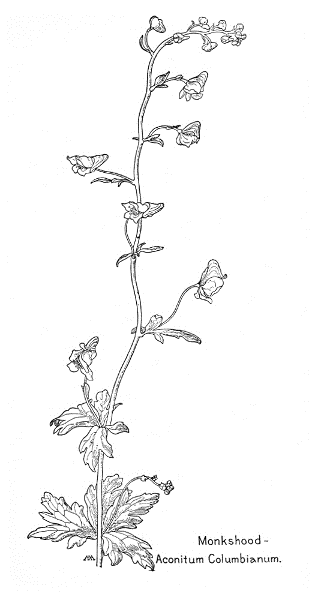
Monkshood – Aconitum Columbianum.

Wild Peony
Paeònia Bròwnii
Dark-red
Winter, spring
Wash., Oreg., Cal.
There are two kinds of Peony. This is a robust and very decorative perennial, rich and unusual in coloring, the fine foliage setting off the dark flowers to perfection. The roots are woody, the stems smooth, from eight inches to a foot and a half tall, and the leaves are smooth, rich green, but not shiny. The nodding flowers are an inch and a half across, with five or six greenish-purple sepals, five or six petals, rich deep-red, tinged and streaked with yellow and maroon; dull-yellow stamens and green pistils. The whole flower is quite thick and leathery in texture and rather coarse, sometimes so dark that it is almost black. The flowers are often fragrant, but the plant has a disagreeable smell, something like Skunk-cabbage, when crushed. The large seed-pods, usually five, are thick, leathery and smooth, with several seeds and are a very conspicuous feature, the stems drooping as they ripen and the pods resting on the ground in big bunches. The whole plant is rather succulent and the foliage and stems are more or less tinged with red and have a "bloom," especially on the sepals. This grows in all sorts of places, in the hot plains of the south and at the edge of the snow, in northern, mountain canyons. In the south it blooms in January and is sometimes called Christmas-rose. The root is used medicinally by the Spanish-Californians and by the Indians, "to give their horses long wind." These plants were named in honor of Paion, the physician of the gods.

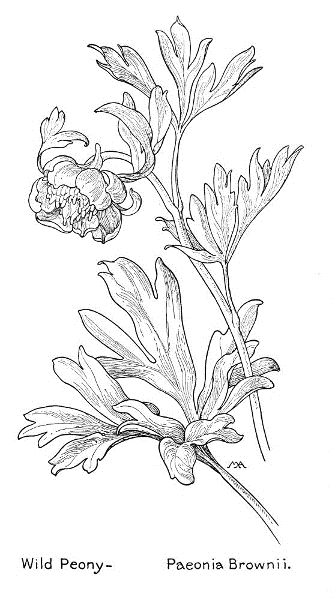
Wild Peony – Paeonia Brownii.

There are only a few kinds of Actaea, tall perennials, with large, alternate, thrice-compound leaves and small, white flowers, in short, terminal clusters. The sepals number about four and resemble petals; the petals are from four to ten, or sometimes none, with claws; the stamens are numerous, with conspicuous white filaments; the one pistil has a broad, somewhat two-lobed, stigma, and the fruit is a large, showy, red or white, somewhat poisonous berry, containing many, smooth, flat seeds.
Baneberry
Actaèa argùta
White
Spring, summer
West, except Ariz.
This is a fine plant, from one to two feet tall, with a stoutish, smooth, branching stem and handsome leaves, prettily cut, with pointed teeth, thin and soft in texture, with conspicuous veins. The sepals and petals of the small cream-white flowers are less conspicuous than the numerous white stamens, which give a very feathery appearance to the flower-cluster, which is one or two inches long and speckled with the dark tips of the pistils. The sepals and petals drop off early and the stamens lengthen, so that the cluster becomes very airy and delicate. The general effect of the plant, which grows near shady mountain streams, is striking and graceful. It grows also in the East and is sometimes slightly sweet-scented, but often has an unpleasant smell. The handsome, poisonous berries are oval or round, red or white, with a polished surface, and contain many seeds. This reaches an altitude of ten thousand feet. A very similar kind, A. viridiflòra, grows in the mountains of Arizona.

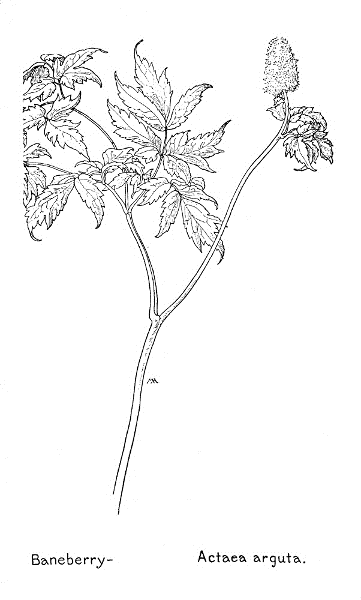
Baneberry – Actaea arguta.
Globe-flower
Tróllius láxus
White
SpringU. S.
This is our only kind of Trollius. It is an exceedingly beautiful flower, particularly when found growing in the snow, or near the edge of a field of melting ice, in high mountains and along the margins of glaciers. The handsome, toothed leaves are palmately-lobed or divided, the lower ones with long leaf-stalks, rich green and glossy and setting off the flowers, which grow singly at the tips of smooth, rather weak stems, from one to two feet tall, and measure about an inch and a half across. The sepals, from five to seven in number, are large, cream-white, slightly greenish outside, and are the conspicuous part of the flower, for the petals are very small and yellow, so that they resemble stamens. From fifteen to twenty-five of these little petals, in a row, surround the numerous, real stamens and form a beautiful golden center. The fruit is a head, measuring an inch across, composed of eight to fifteen small pods, with beaks, containing many, smooth, oblong seeds. This plant looks very much like an Anemone but it has these small yellow petals and Anemones have none, and the center is larger and brighter yellow and the foliage coarser.

